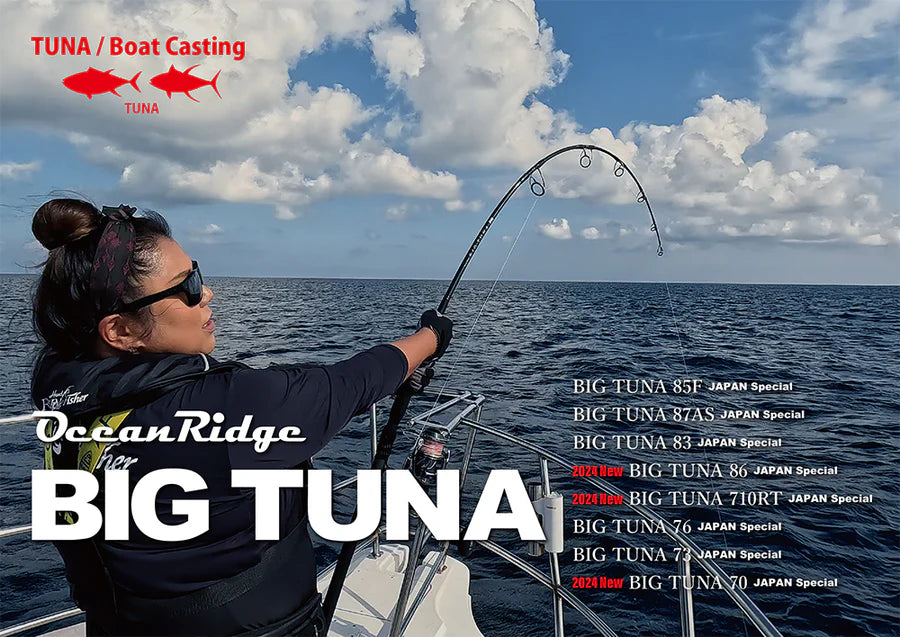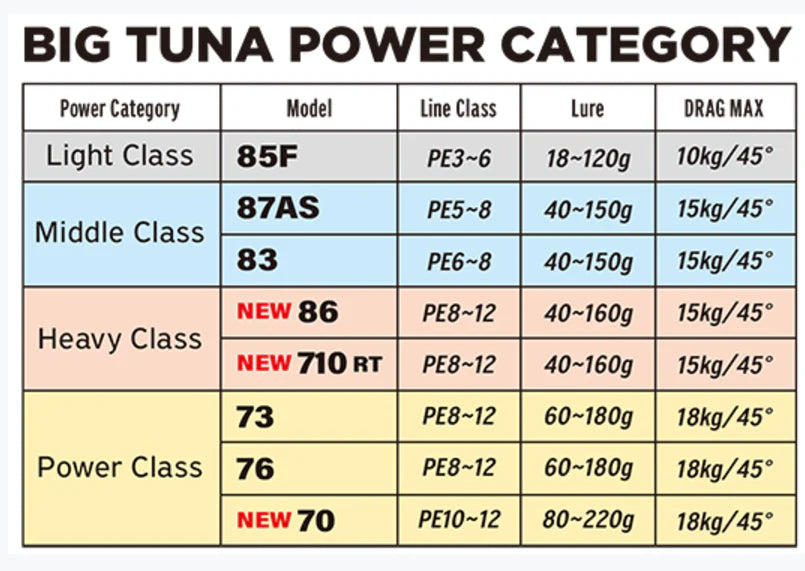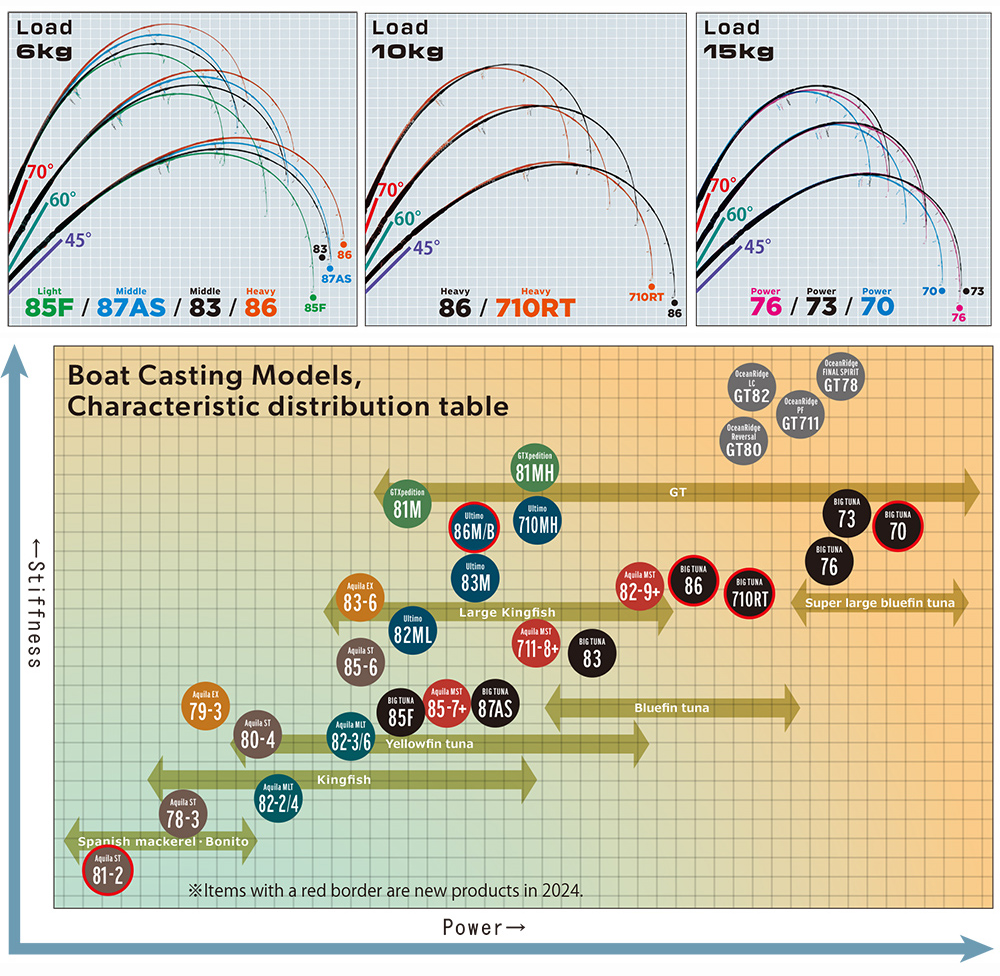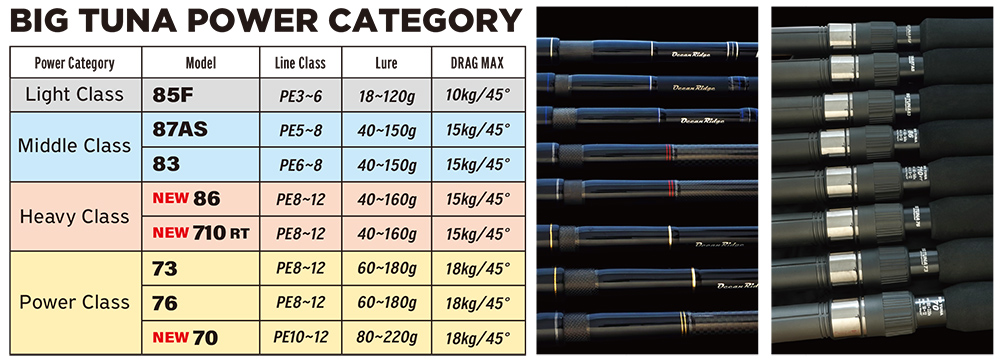


Ripple Fisher Big Tuna 76 Japan Special
Ripple Fisher Big Tuna 76 Japan Special
North Willoughby
340 Penshurst Street
North Willoughby NSW 2068
Australia
This model is for anglers with their sights on Bluefin tuna weighing over 200kg. Similar to the 73, this 76 is capable of not only casting large lures mostly used when the targets are feeding on dolphin fish (mahi-mahi), but also allows anglers to cast and control the lighter (60g) sinking pencils for smaller baits. The difference from the 73 will be the contrasting fight style. While possessing strong butt power to constantly apply pressure on the fish, we have drastically reduced the load on the angler by bringing the bending point closer to the angler, allowing for a prolonged fight.

- Length: 7ft 6in (Closed Length: 1575mm)
- Weight: 398g
- Sections: 2pcs / Grip-Joint
- Lure Weight: 60–180g
- Line: PE 8–12
- Action: Regular Fast
- Target: Tuna (up to 200kg+)
- Specifications: Equipped with Fuji Super Ocean Guides
- Maximum Drag: 18kg at 45° angle
Suitable Reel Size:
-
Shimano & Daiwa (new): 18000–30000
-
Daiwa (Old): 6500–8000
Grip Length:
-
Full Grip Length: 838mm
-
From Grip End to Reel Foot: 520mm
Tip Diameter: 3.0mm (measured just below the top guide)
Butt Diameter: 15.3mm (measured 900mm from the tip end)
Reel Seat: Fuji DPS20 (Down Lock)
Grip End: Gimbal※
※BRC or Gimbal — model with interchangeable specifications
BIG TUNA Comparison
Here are the bending curves of the different models in the BIG TUNA series with a static weight and differing anglers. It will give you an understanding of the bending point and how much power is left in the butt section.
*the picture may not illustrate the actual power of the rod due to the differing rod length and angle.
The 85F and 87AS are more flexible able to cast small lures and designed for a more mellow fight with the fish, whereas the 83 and 86 are a more aggressive rod with the bending point towards the tip to efficiently lift and fight the fish. Compared with the same middle-class rods of 87AS, the 83 is a one rank stronger rod.
The illustration shows the comparison of the 2 heavy class rods. Both rods have a similar taper design but the difference lies in the length. By utilizing the length of the 86 blank, anglers will be able to cast farther than other shorter rods while the shorter 710RT is a model able to load the blank with the weight of the fish with ease.
The picture illustrates the comparison of the 3 power class models. When looking at the comparison with a 45 degree angle, the 73 and 76 look similar, however, the bending point of the 76 is closer to the angler, reducing the stress on the angler, while the 73 is further away enabling a more speedy fight against the fish. The newly added 70 has the strongest butt power with the bending point being close to the angler, drastically reducing the load on the angler. The three models are the same power class, yet having totally different characteristics. *when choosing a tuna rod, please be sure to choose the most suited rod depending on your height, weight, strength and experience.

In the BIG-TUNA series, the power category is set to make the rod characteristics easier to understand.
For example, among the 86, 710RT, 73, 76, and 70 that have the same line max value, the 73, 76, and 70 are designed to increase the breaking strength in order to target the extra-large class. The 86 and 710RT come in different power categories and can be used in situations where a distant throw is required, such as a lure, or in situations where a finer lure is required.
The 85 F, 87AS, and 83 are models that can also be used to target yellowfin tuna, and are generally considered to be 85 F for tuna sizes under 50 kg, or 87AS and 83 for tuna sizes under 80 kg.
Please consider the lure size, line, size of tuna, and required lure appeal when selecting a model.
The rod design of the BIG-TUNA series is color-coded with thread colors that match the power class below. Also, the model name is engraved on the spacer on the reel sheet of the grip.

Please read the warranty policy carefully before purchasing a JDM (Japan Domestic Model) Rods/Reels.
The JDM Rod/Reels come with a Japan domestic warranty (which is the Japanese standard) and it is effective one year from the date of purchase to the original purchaser. There is no warranty card for reels, and you only need to provide the purchase receipt for claiming it. A warranty card will come with most of rods (except some low-price rods) and you need to provide it along with the purchase receipt.
The warranty does not cover claims arising from normal wear and tear, improper use or neglect or servicing. However, you have a chance to replace the broken section of the rod(multi-piece rods) or the whole rod(one-piece rods) within the one year warranty period(except some low price rods).This warranty service is available to use only one time and there is an excess fee (written on the warranty card) occurs. Also there is a $50 of international shipping fee occurs.
These rods/reels are only sold in Japan and no service or repair are available in Australia and we need to send them back to Japan. The service and repair fee will be quoted by manufacturer, and we charge a $50 of international shipping fee.
We will do our best to provide appropriate repair assistance given the nature of the damage.
Note: We accept warranty repair / service requests from existing customers but are unable to accommodate the requests for items purchased at another store.
日本国内型号渔竿、渔轮保修须知
请在购买日本国内型号渔竿、渔轮前阅读保修条款。
本店的日本国内型号渔竿、渔轮在进口时附带的是日本国内保修卡(条款符合日本国内标准)。保证书从购买之日起生效,有效期为一年,仅限原购买者有效。一般来说,本店日本进口渔竿会附带一张日本保修卡(一些低价入门杆除外),在送修时需要与购买凭证一起出示。本店日本进口渔轮一般不会附带日本保修卡,送修是仅需提供购买凭证即可。
正常使用痕迹、疏忽所造成伤害和错误使用或维护所造成的损伤不在保修范围之内。在一年保修期内,客户可以一次性使用相应保修卡更换受损渔竿的一节(多节杆)或整支(一节杆)。保修卡只能使用一次,而且需要支付出险费(金额在保修卡上列出)和国际运费(通常为$50)。渔轮如出现问题,厂家技术员会判断损坏原因,并只对制造过程中的缺陷进行质保。
因为日本本地进口渔竿和渔轮在澳洲没有维修点,所以我们在您申请保修时需要将它们送回日本维修或更换。不在保修期内或是不在保修范围内的渔具,厂家会对修理的的费用进行报价,本店也会收取$50的国际运费。
本店会尽我们的最大努力去服务我们的客户,和日本本地厂商一起向客户提供优质的维护和维修服务。
注意: 本店只向本店的客户群体提供售后服务,无法向非本店出售商品提供售后维修服务。
Coastal Fishing Tackle Online shopping gives customers secure, easy & convenient shopping.
Order Process
1. Unless previously quoted, you accept that if any unforeseen additional freight costs occur we will contact you and given the choice to either continue with your order and incur additional freight charges or cancel your order and receive a full refund.
2. Once payment has been accepted, we will process your order within 1-3 days and dispatched unless otherwise advised.
3. We will contact you via email if delays in shipping occur.
4. All prices are correct at time of publication, however we reserve the right to alter prices for any reason. If this happens after you have ordered a product, we will contact you prior to processing your order.
5. Due to changing market forces and other extenuating circumstances that affect product availability, and price stability we reserve the right to withdraw any product we advertise and change prices without notice.
Information contained throughout the web pages is believed to be accurate at the time of publishing. There may be misprints, human errors or omissions. We reserve the right to make changes and corrections in prices, products and specifications without notice.
We reserve the right to alter the agreed price if an incorrect price was caused by a software fault, error.
Payments method
We accept below payments method:
- Online payment (Paypal, Credit Card, AfterPay, ZIP Pay)
- Bank Deposit
- Cash payment (Local pickup)
- Australia Domestic Shipping
- Orders over $150, size under 3kg weight/cubic : Free
- Orders under $150, size under 3kg weight/cubic : $8
- Orders more than 3kg in weight/cubic will be calculated during checkout.
- FREE Pick up is available from North Willoughby NSW during the opening hours.
- International Shipping
- New Zealand
- Order size under 500g weight/cubic : $15
- Order size under 1kg weight/cubic : $20
- Order size under 2kg weight/cubic : $25
- Other countries
- Order size under 500g weight/cubic : $25
- Order size under 1kg weight/cubic : $35
- Order size under 1.5kg weight/cubic : $50
- Order size under 2kg weight/cubic : $65
- We don't ship Items over 1m in length internationally as above rate. Please contact us (info@coastalfishing.com.au) for a shipping quote.
- When shopping internationally you may incur customs charges, duties and GST from your Governments Customs Service. In most cases, any customs or import duties are charged once the parcel reaches your country. These charges are the responsibility of the person receiving the parcel and Coastal Fishing Tackle will not pay for or reimburse you for any of these charges and duties.
* Items over 1m can't be delivered to a PO Box or Parcel Locker (only a residential address or business address).
** In the very rare case that an order incurs a higher postage rate than displayed (bulky items etc), Coastal Fishing Tackle reserves the right to request an additional postage charge and you will have the option to either cancel the order or continue with the order and incur the additional postage charge.
- Shipping Time Frame
We will contact within 2 business days if any problem arise regarding your order otherwise all orders will be shipped within 1-2 working days after payment is cleared. You will be notified by email once your order has been shipped. Standard delivery is approximately 1 to 4 business days for metropolitan areas and approximately 4 to 10 business days to other areas.

